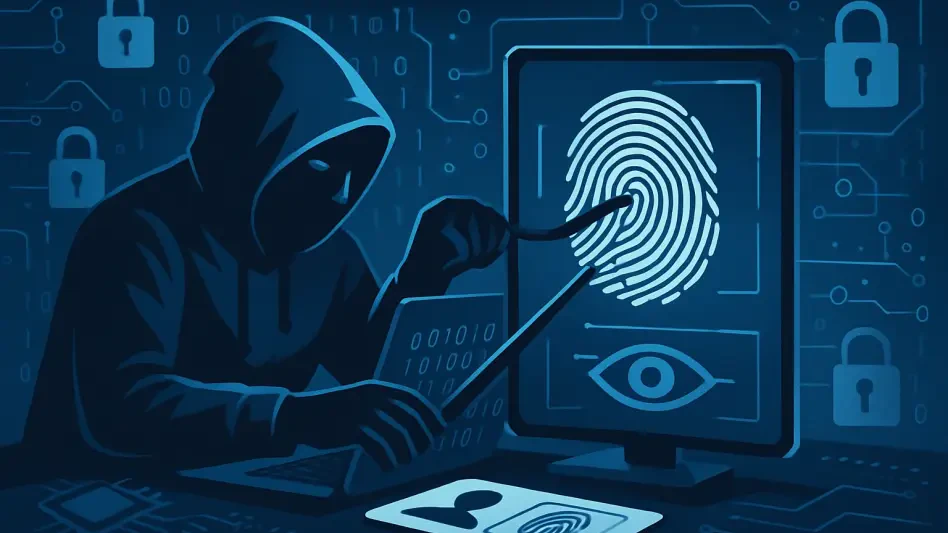In an era where digital innovation permeates every aspect of daily life, the theft of biometric data—unique identifiers such as fingerprints, facial features, iris scans, and voiceprints—has emerged as a chilling new frontier in cybercrime, threatening personal and global security in unprecedented ways. Once heralded as a foolproof alternative to traditional passwords, this deeply personal information is now fueling a staggering $10.5 trillion shadow economy on the dark web. Unlike a stolen credit card or breached password that can be replaced, biometric data is permanent, rendering its loss uniquely catastrophic. The implications stretch far beyond individual privacy, touching on national security and institutional vulnerabilities. This exploration delves into the transformative impact of biometric data theft on the cybercrime landscape, uncovering the sophisticated tactics of modern hackers, the systemic weaknesses that enable these breaches, and the urgent need for robust defenses to protect what makes each person distinct in an increasingly digitized world.
The Unmatched Value of Biometric Data
The intrinsic permanence of biometric data elevates its worth to cybercriminals, positioning it as a prime target in an underground market where personal identity is a high-stakes commodity. On the dark web, entire databases of facial recognition profiles and voiceprints are auctioned off, with reports indicating that nation-states like China and Russia account for a staggering 77% of these acquisitions. Unlike a Social Security number, which can be monitored or reissued under certain conditions, a compromised fingerprint or iris scan provides lifelong access to a victim’s identity. This irreplaceable quality transforms biometric information into a currency of unparalleled value, driving a black market where biological traits are bought and sold as tools for exploitation. The consequences ripple through financial systems and personal lives, as stolen data becomes the key to unlocking everything from bank accounts to private communications, with little recourse for those affected.
Beyond mere financial theft, the hijacking of biometric data enables a profound invasion of personal identity that redefines the boundaries of cybercrime. Criminals can effectively “become” their victims, using stolen identifiers to bypass security protocols or create convincing deepfakes that manipulate trust and authenticity. With projections estimating a 126% surge in ransomware attacks in the near term and cyberattacks potentially striking every two seconds by 2031, the urgency to address this threat intensifies. The scale of the risk is magnified by the fact that biometric breaches don’t just compromise data—they compromise the very essence of who a person is. This evolution from traditional identity theft to biological exploitation marks a critical shift, demanding heightened awareness and innovative strategies to safeguard information that, once lost, cannot be regained or replaced in any meaningful way.
State-Sponsored Threats and Geopolitical Stakes
The involvement of nation-states in biometric data theft adds a complex geopolitical dimension to what was once considered a primarily individual or corporate crime. Government-backed groups, such as China’s Salt Typhoon and North Korea’s Lazarus Group, are not merely opportunistic actors but strategic players using stolen data to fund illicit programs, disrupt critical infrastructure, and secure geopolitical leverage. These entities target biometric information to bypass security systems or influence global markets, transforming personal data into a weapon of statecraft. The implications extend far beyond isolated breaches, as the theft of such data can undermine trust in international systems and exacerbate tensions between nations. This state-sponsored dimension underscores the need for a coordinated global response to a threat that transcends borders and traditional definitions of criminal activity.
Moreover, the strategic use of biometric data by nation-states often intertwines with broader agendas, amplifying the stakes of each breach. For instance, stolen facial data or voiceprints can be leveraged to create sophisticated disinformation campaigns or access sensitive governmental systems, posing risks to national security. High-profile incidents, like the manipulation of stolen data to fund controversial programs, highlight how these actions are not random but part of calculated efforts to gain dominance in a digital battleground. The convergence of cybercrime with geopolitical objectives reveals a troubling reality: biometric data is no longer just a personal asset but a critical piece in a larger chess game of power and control. Addressing this challenge requires not only technological innovation but also diplomatic efforts to establish norms and accountability in the use and protection of such sensitive information.
Systemic Vulnerabilities in Public and Private Sectors
Public spaces, once perceived as secure, have become fertile ground for biometric data theft due to inadequate safeguards and overzealous data collection practices. Venues like sports stadiums and airports, often referred to as “data coliseums,” prioritize analytics and convenience—such as ticketless entry systems—over robust security measures. Breaches like the Qilin ransomware gang’s $350 million exploit of Milwaukee stadium data expose how protections in these environments can be as flimsy as those guarding a basic Wi-Fi-enabled device. Such incidents reveal a systemic failure to balance innovation with privacy, leaving vast amounts of sensitive information vulnerable to exploitation. The ease with which hackers access these systems underscores a critical need to reevaluate how biometric data is handled in everyday settings where millions interact with technology without a second thought to the risks involved.
In parallel, private sectors, including telecom giants and other data-heavy industries, often fall short in fortifying their defenses against biometric threats. Many organizations collect extensive personal data without implementing commensurate security protocols, creating easy entry points for cybercriminals who exploit even the smallest gaps. The drive for competitive advantage through data analytics frequently overshadows the imperative to protect individual privacy, resulting in a landscape where convenience trumps caution. This systemic weakness is evident in the recurring pattern of breaches that compromise not just financial records but the very identifiers that define a person. Strengthening these sectors demands a cultural shift toward prioritizing security as much as innovation, ensuring that the rush to digitize doesn’t leave critical vulnerabilities unaddressed in an era where data is both an asset and a liability.
Regulatory Shortcomings and Global Disparities
The regulatory response to biometric data theft remains fragmented and often outpaced by the rapid evolution of cyber threats, leaving significant gaps in protection across the globe. While the European Union has taken decisive steps with frameworks like the GDPR, enforcing strict consent requirements and imposing substantial fines for non-compliance, other regions, such as the United States, struggle with a patchwork of state laws and less stringent penalties. This inconsistency creates a fertile environment for hackers who exploit regulatory loopholes, targeting areas with weaker oversight to maximize their gains. The disparity in global approaches not only hampers efforts to combat biometric theft but also highlights the borderless nature of the threat, where a breach in one jurisdiction can have cascading effects worldwide, undermining trust in digital systems on a massive scale.
Compounding this challenge is the sluggish pace at which regulations adapt to the sophistication of modern cybercrime tactics. Even in regions with advanced policies, legislation often plays catch-up to hackers who innovate faster than laws can be drafted or enforced. For example, during periods of rapid technological change, such as the shift to alternative biometric systems when facial recognition faltered, criminals quickly adapted to harvest voice data and other identifiers. This lag in regulatory frameworks reveals a broader societal struggle to balance privacy rights with the realities of a digital ecosystem where personal data is perpetually at risk. Bridging these gaps requires not just national policies but international cooperation to establish unified standards that can keep pace with the relentless ingenuity of cybercriminals exploiting biometric vulnerabilities.
Forging a Defense Against Biometric Exploitation
Addressing the crisis of biometric data theft necessitates a multifaceted strategy that combines cutting-edge technology with heightened personal and institutional accountability. Innovations such as quantum-encrypted storage, 3D liveness detection, and thermal signature layering offer promising avenues to secure sensitive information against unauthorized access. These advanced tools can help detect and deter sophisticated attacks, ensuring that stolen data cannot be easily weaponized. Simultaneously, individuals must adopt practical measures, such as enabling biometric timeouts on devices and scrutinizing the data collection practices of organizations they interact with. This dual approach of leveraging technology while fostering vigilance creates a stronger barrier against the pervasive threat of biometric exploitation, safeguarding the unique traits that define human identity in a digital age.
Looking back, the battle against biometric data theft was marked by a sobering recognition of how deeply personal information had been commodified in a sprawling shadow economy. Yet, the path forward hinges on actionable steps that were identified to counter this evolving menace. Governments must prioritize harmonized regulations that close exploitable gaps, while industries need to shift from reactive fixes to proactive security models like zero-trust architectures. Collaboration across borders emerged as a vital necessity to combat a threat that knows no boundaries. Ultimately, the protection of biometric data was understood to be not just a technical challenge but a fundamental imperative, demanding sustained investment and a collective commitment to preserve the essence of individuality against the relentless advance of cybercrime.








